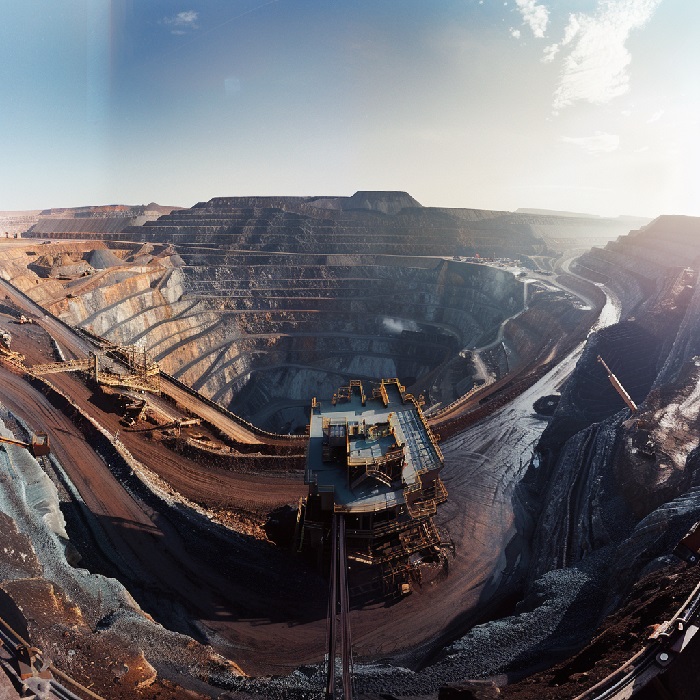Uranium Mining
URANIUM:
Most uranium mining conducted today employs the in-situ leaching technique. This method doesn't involve digging at the surface or underground. The minerals obtained through this technique are mostly soluble, such as potash, potassium chloride, sodium chloride, sodium sulfate, and uranium oxide, which can be dissolved in water.

Uranium is used as a coloring agent in uranium glass, producing shades ranging from orange-red to lemon yellow. It was also utilized for tinting and shading in early photography. The discovery of uranium in the mineral pitchblende in 1789 is credited to Martin Heinrich Klaproth, who named the new element after the planet Uranus.
Cultured uranium is a silvery-white, faintly radioactive metal, slightly softer than steel, strongly electropositive, and a good electrical conductor. It's malleable, ductile, and somewhat paramagnetic. Uranium metal has an extremely high density, approximately 70% denser than lead but slightly less dense than gold.
The primary military application of uranium is in high-density penetrators. This ammunition consists of depleted uranium (DU) combined with 1-2% other compounds. At high collision speeds, the density, hardness, and penetrability of the projectile aid in the destruction of heavily fortified targets.
Tank armor and detachable armor on combat vehicles are also reinforced with depleted uranium (DU) plates. The use of DU became a contentious political and environmental issue after its use in ammunition by the US, UK, and other countries during wartime in the Persian Gulf and the Balkans raised concerns about residual uranium elements left in the soil.
The primary civilian use of uranium is to fuel commercial nuclear power plants; when fully fissioned, one kilogram of uranium-235 can potentially generate about 20 trillion joules of energy (20 × 10^12 joules), equivalent to the electrical energy produced by 1500 tons of coal.
The process of extracting uranium ore from the ground is uranium mining. There are several extraction methods used in uranium mining, including solution mining, underground mining, open-pit mining, and heap leaching.
URANIUM MINING:

Solution mining
The solution mining method, commonly known as in-situ leaching in North America, extracts uranium without any ground disturbance. The uranium ore in the ground is dissolved and pumped to the surface for mineral recovery. This process is carried out when the orebody's aquifer is ideally confined vertically and horizontally. Groundwater with high oxygen content, or oxidant, is circulated through the enclosed underground aquifer to dissolve the uranium ore. The leaching solution, which dissolves the uranium, is then pumped to the surface treatment plant. After filtration and treatment, the uranium is recovered as precipitate. Hydrogen peroxide is typically used as the oxidant in in-situ leaching, although different countries may use various solutions to dissolve the uranium ore.
Open pit mining
When uranium ore lies close to the surface, it is accessed by open-pit mining. In this method, a large pit is dug, and the overburden or waste rock is removed to reach the ore. It is extracted through a series of steps, including drilling, blasting, and excavation. Since open-pit mining is more vulnerable to radiation, workers often spend much of their time in enclosed cabins. The airborne dust level is minimized by the use of water.
Underground mining
Underground mining is employed when the ore bodies are deeper or farther below the surface of the earth. Shafts and tunnels are dug to access and remove the uranium core. Compared to open-pit mining, the removal of waste is reduced in underground mining. Different methods can be employed based on the availability of the ore. When the ore is abundantly present in a single place, the open stoping method can be used. In this method, the excavated area is refilled with waste rock and cement. In the shrinkage method, miners work on top of the pile to drill and blast to remove the ore, leaving a large hole at the end. When the ore is flat or thin, the room and pillar method is followed. In this method, the ore body is divided into blocks, and ores are removed systematically, leaving enough ore for roof support.
Heap leaching
Heap leaching involves the use of chemicals like sulfuric acid to extract the economic element from the ore that has been mined and placed on the surface. This method is employed only for oxide ore deposits. In other cases, a low molar concentration of sulfuric acid is used as the leaching agent, which is sprayed on the ore for 30 to 90 days. The uranium breaks its bonds and allows it to enter the solution. The solution is then pumped and sent for further processing.
The uranium produced by in-situ leaching or solution mining constitutes 57% of the world's production, while open-pit mining and underground mining constitute the remaining 43% of production.











